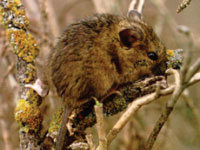Salt marsh harvest mouse facts for kids
Quick facts for kids Salt marsh harvest mouse |
|
|---|---|
 |
|
| Conservation status | |
| Scientific classification | |
| Genus: |
Reithrodontomys
|
| Species: |
raviventris
|
The salt marsh harvest mouse (Reithrodontomys raviventris) is a small rodent that lives in the San Francisco Bay Area of California. It is also known as the red-bellied harvest mouse. This mouse is an endangered animal, meaning its population is very low and it is at risk of disappearing forever.
These mice live only in the salt marshes around San Francisco Bay. There are two different types, called subspecies, and both are endangered. The northern subspecies (R. r. halicoetes) has lighter fur. It lives in the northern parts of the bay. The southern subspecies (R. r. raviventris) has darker fur. It lives in the East and South Bay marshes.
Contents
Meet the Salt Marsh Harvest Mouse
The salt marsh harvest mouse is a small creature. An adult mouse is about 5 to 7 centimeters (2 to 3 inches) long. Its tail adds another 6 to 10 centimeters (2 to 4 inches). It weighs around 10 to 20 grams (0.4 to 0.7 ounces).
What Does It Look Like?
The southern subspecies has dark brown fur on its back. Its belly is usually a pinkish-cinnamon or tawny color. Its tail has two colors, matching its body.
The northern subspecies is brown or reddish-brown on its back. Its belly is often white or cream. Sometimes, it might have a slight reddish tint. Its tail is usually a bit longer than its body. These mice have special grooves on their upper incisor teeth.
When Are They Active?
These mice are nocturnal, which means they are most active at night. They are especially busy on nights when the moon is bright. They are very clever and can use paths made by other rodents on the ground. They are also good at climbing.
What Do They Eat?
The salt marsh harvest mouse eats seeds and plants. Their favorite food is pickleweed. They also enjoy glasswort, which is another common plant in salt marshes.
Who Are Their Predators?
Many animals hunt these mice. These include different types of hawks, snakes, and owls. Shorebirds and larger mammals also prey on them. Pet cats can be a problem too, especially when human homes are built close to the mouse's habitat.
Life in the Marsh
As their name suggests, these mice live in salt marshes. This means they are very good at living in salty places. They can swim well and can handle salt in their food and water.
How Long Do They Live?
Studies show that salt marsh harvest mice can live up to 18 months, and sometimes even longer. Female mice usually have two litters of babies each year.
Surviving Salty Water
In the summer, the water and plants in the marsh become saltier. This is where the mice have a special advantage. They can drink and survive purely on salt water! The northern subspecies prefers fresh water but can live on salt water. The southern subspecies can live on either and does not show a preference.
Where Do They Live?
The mice rely heavily on thick plant cover. Their main home and food source is pickleweed. They also use other marsh plants like tules (Schoenoplectus species). They live in different marsh areas, including those with dikes and those affected by tides.
Living Together
Salt marsh harvest mice are not aggressive. Many mice can live close together. They can handle crowded conditions for short times. This happens when seasonal floods force them onto small patches of dry land. They can also survive floods because they are excellent swimmers and climbers.
Their Home Range
The area a mouse uses, called its home range, changes with age and sex. Young mice use smaller areas, about 600–700 square meters. Adult mice use larger areas, about 1300–1500 square meters.
Males and females use different parts of their habitat during fall and summer (breeding season). But they use the same areas in winter and spring. Scientists think this might be to avoid predators or competition. The mice also travel different distances within their home ranges depending on the season. They travel the most in June and the least in November.
Where Can You Find Them?
This special mouse can be found in specific places around the San Francisco Bay:
- Napa Sonoma Marsh, near Sonoma Creek
- Suisun Marsh, in Solano County
- Alman Marsh, next to Shollenberger Park in Petaluma
- Sausalito baylands
- San Rafael baylands
- Arrowhead Marsh in Oakland
- San Francisco Bay sloughs in Alviso
- Palo Alto baylands
- Bair Island
- Point Reyes National Seashore
Protecting the Mouse
The salt marsh harvest mouse has lost a lot of its home. This is due to buildings being built near the bay, pollution, boat traffic, and commercial salt harvesting. It has been on the endangered species list since the 1970s. Its habitat is now protected in many wildlife refuges around the Bay Area.
Local governments are also working to protect the mouse. For example, the city of San Rafael, California, has rules that stop new buildings within 50 feet of the shoreline. This helps protect the mouse's habitat. Researchers like Katherine Smith are studying how things like climate change affect the mouse. This helps us understand more about its life and how to protect it.
A Mouse in the News
The protection of the salt marsh harvest mouse's habitat was even talked about in the 2009 economic stimulus package. Some politicians, like Rep. Mike Pence and Rep. Dan Lungren, mentioned the mouse in Congress. They used it to question some of the spending in the bill. A rumor started that $30 million would be spent on restoring the mouse's habitat. However, this was later shown to be incorrect by other politicians, like Rep. Jackie Speier.



